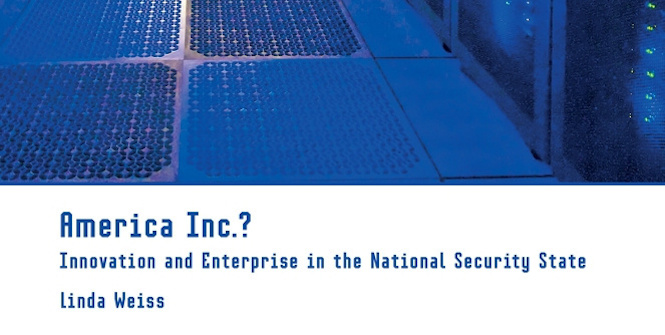America Inc.?

In December 2015 new Australian Prime Minister Malcolm Turnbull promised to drive an “ideas boom” with his Innovation Statement outlaying $1.1 billion for research and development. It is therefore timely that we can reflect on Linda Weiss’ America Inc.? as she poses the compelling question: how do we explain the US innovative capacity that fostered all advanced telecommunication, computer, microelectronic, software and biotech industries since WWII? Her scholarly thesis, frequently stated in the text, debunks a conventional anti-statist mythology by providing a persuasive argument demonstrating instead that the integration of state and market has driven innovation. Throughout, Weiss argues for three interlinked propositions: that a National Security State (NSS) which extends well beyond a military-industrial complex to the incorporation of commercial ventures is also a technology enterprise designed to sustain defence hegemony; the catalyst for the formation of the NSS as such has been exogenous geopolitical drivers; and that domestic political anti-statism has produced a preference for the hybrid organisational forms that have fostered the effective achievement of US security objectives.
Central to Weiss’s argument stands her clearly articulated analytical conceptualisation of a NSS which comprises core US defence, science, health departments and agencies together with university contractors, national laboratories, industry contractors and innovation hybrids. As it has developed, the promotion and maintenance of national security primacy is paramount and the commercial sector is used to support these ends. In redefining the state-market relationship, Weiss argues that the NSS, as innovation catalytic and hybrid constructor, is consummately a problem setter, the provider of substantive funds for high-tech projects, a network node, and also an end user. Moreover, she claims that the NSS has been integral to the conception and flourishing of venture capital markets. In that way, the commercial sector, which may have been inclined to eschew state security projects, found commercially attractive incentives to participate in NSS projects. Thus, Weiss’s NSS is unconventionally and profoundly proactive in the manner in which it sponsors research and development. Far from being enclavist in its modality, the NSS has broad and dispersed reach. And as Weiss proceeds to demonstrate through each of her chapters, the NSS has maximised an evolutionary reciprocity between national security and market settings, where a “spin around” effect aptly describes the way technology is developed and used across the two sectors.
So, while readers might be quite familiar with the story of an American private sector quest for innovation, Weiss’s achievement is to disclose the breadth by which the state has operated to foster the incorporation of private sector goals and resources to benefit the security of the state. Hence, the NSS relationship with the private sector can more aptly be described as one of “governed interdependence”. In effect, Weiss’s own innovation is to drive readers to the conclusion that, for the US, “domestic political value sets, preferences, and institutions mediate the state’s involvement in techno-innovation—not by diminishing or limiting state capacity but by extending its infrastructural power and creating a hybrid political economy.”
Weiss has judged that over the past 70 years, three variant geopolitical threats to the US have galvanised or challenged the NSS to fulfil its security objectives. Weiss observes that the Soviet Sputnik space program provided the impetus for the NSS integration. Claims of Soviet parity in nuclear weapons and delivery systems that accompanied Soviet human resource strength, spurred the NSS to an offset strategy firmly located in technology development. Correspondingly, although not explored in detail, is the 1970s rise of Japanese technological prowess in an era of neoliberalism, which fostered the re-emphasis of commercial goals and embraced the new frontiers in the biotech space. And yet now, Weiss claims that in the era of the asymmetric and decentralised challenges of 9/11, the NSS future appears less certain. The processes of financialism as manifest through the 2008 great recession and its enduring legacy, together with the separation of innovation and production in processes of offshoring and as exacerbated by congressional gridlock, raise questions for the continued efficacy of the NSS.
Undoubtedly, this is a well-crafted weave of national security, political economy and political arguments. It is also absorbing. In addition to the breadth of the insight, its scholarly strength also lies in its clinically ordered and chronological explanation of the NSS as a profoundly pervasive architect and operator: a provider of patient capital, absorbing risk in search of innovation with both “spin off” and “spin around” national security objectives and effects. Further, the research base for the contention is extensive. Each section is well supported by a welter of illustrative material revealing the commercial reach, integration, and effect of the NSS and the summary tables are deployed to effect. The reader, who is offered insights into its reach, is however left wanting to know more on some of the key case studies such as the NSS-supported Small Business Innovation Research program, reputedly the “world’s largest seed fund”, and the CIA’s own venture fund, In-Q-Tel, and indeed its Google partnerships.
While America Inc.? is not a book for those desiring a normative critique of US policy, it is, instead, an invaluable analytical explanation as to how the US has been preeminent in its inexorable innovative drive to achieve and maintain its defence primacy. As such, Weiss lays out a forceful challenge to the traditional conceptualisation of the US as a paradigmatic liberal capitalist state.
Linda Weiss, America Inc.? Innovation and Enterprise in the National Security State, Cornell University Press, Ithaca, 2014.
Reviewed by Dr Maryanne Kelton, Senior Lecturer, Flinders University





